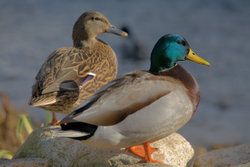|
Ducks |

A female and male
Mallard
|
|
Scientific classification |
| Kingdom: |
Animalia
|
| Phylum: |
Chordata
|
| Class: |
Aves
|
| Order: |
Anseriformes
|
| Family: |
Anatidae
|
|
| Subfamilies |
Dendrocygninae
Oxyurinae
Anatinae
Merginae |
Duck is the common name for a number of species in
the
Anatidae family of
birds. The ducks are divided between several subfamilies
listed in full in the Anatidae article. Ducks are mostly
aquatic birds, mostly smaller than their relatives the
swans and
geese, and may be found in both fresh water and sea
water.
Most ducks have a wide flat
beak adapted for dredging. They exploit a variety of food
sources such as grasses, grains and aquatic plants, fish,
and insects. Diving ducks forage deep underwater; Dabbling
ducks feed on the surface of water or land. Dabbling ducks
have special plates called lamellae[1] that are similar to a
whale's baleen. These tiny rows of plates along the inside
of the bill allow them to filter water out of the side of
their bills and keep food inside. To be able to submerge
more easily, the diving ducks are heavier than dabbling
ducks, and therefore have more difficulty taking off to fly.
A few specialized species (the goosander and the mergansers) are adapted to catch large fish.
In Ohio, one of a duck's biggest enemies is the
muskie, which has been known to eat fully grown ducks.
In Britain, big
pike have been known to swallow fully grown wild ducks
whole, and pike often take small ducklings.
The males (drakes) of northern species often have
extravagant
plumage, but this is moulted in summer to give a more
female-like appearance, the "eclipse" plumage. Many species
of ducks are temporarily flightless while moulting; they seek out protected habitat with good food
supplies during this period. This moult typically precedes
migration.
Some duck species, mainly those breeding in the temperate
and arctic
Northern Hemisphere, are
migratory, but others are not. Some, particularly in
Australia where rainfall is patchy and erratic, are
nomadic, seeking out the temporary lakes and pools that form
after localised heavy rain.
Some people use "duck" specifically for adult females and
"drake" for adult males, for the species described here;
others use "hen" and "drake", respectively.
Ducks are sometimes confused with several types of
unrelated water birds with similar forms, such as loons or
divers, grebes, gallinules, and coots.
Etymology
The word duck from (Anglo-Saxon dūce) meaning the
bird, came from the verb "to duck" (from Anglo-Saxon
supposed *dūcan) meaning "to bend down low as if to get
under something", because of the way many species in the
dabbling duck group feed by upending (compare the Dutch word duiken = "to dive").
This happened because the older
Old English word for "duck" came to be pronounced the same
as the word for "end": other Germanic languages still have
similar words for "duck" and "end": for example, Dutch eend
= "duck", eind = "end"; compare Latin anas (stem anat-) =
"duck", Sanskrit anta (masc.) = "end", Lithuanian antis = "duck".
Ducks and humans
In many areas, wild ducks of various species (including
ducks farmed and released into the wild) are hunted for food
or sport, by
shooting, or formerly by decoys. From this came the expression "a sitting duck",
which means "an easy target".
Ducks have many economic uses, being farmed for their
meat, eggs, feathers and down feathers. They are also kept
and bred by aviculturists and often displayed in zoos. All
domestic ducks are descended from the wild Mallard Anas
platyrhynchos, except Muscovy Ducks[2]. Many breeds have
become much larger than their wild ancestor, with a "hull
length" (from base of neck to base of tail) of 30 cm (12
inches) or more and routinely able to swallow an adult
British Common Frog, Rana temporaria, whole.
Foie gras is often made using the liver of ducks, rather
than of geese.
In a wildlife pond, the bottom over most of the area
should be too deep for dabbling wild ducks to reach the
bottom, to protect bottom-living life from being constantly
disturbed and eaten by wild ducks dredging, and
domestic ducks should not be allowed in.
Generally, the sound made by ducks is called a "quack". A
common false
urban legend asserts that quacks do not echo.[3]
Ducks and humor
In
2002, psychologist Richard Wiseman and colleagues at the
University of Hertfordshire (UK) finished a year-long
LaughLab experiment, concluding that, of the animals in the
world, the duck is the type that attracts most humor and
silliness; he said "If you're going to tell a joke involving
an animal, make it a duck." The word "duck" may have become
an inherently funny word in many languages because ducks are
seen as a silly animal, and their odd appearance compared to
other birds. Of the many ducks in fiction, many are silly
cartoon characters (see the
New Scientist article
[1] mentioning humor in the word "duck").
Trivia
- Some Ancient Egyptian wall pictures show that (some
of) the ships of the
Sea Peoples had ornamental prows shaped like a duck's head.[4]
Gallery
|
|
|
Ruddy Shelduck - not a true duck but a
member of the Tadorninae
|
Male
Wood Duck in eclipse plumage
|
|
|
Female Mallard with ducklings
|
|
|
|
|
|
A duck enjoying the afternoon
|
A duck right after a swim
|
Mandarin Duck at Slimbridge Wildfowl and
Wetlands Centre, Gloucestershire, England.
|
Ten ducklings follow their mother.
|
|
Daffy Duck and Bugs Bunny in the famous 1952
Merrie Melodies cartoon Rabbit Seasoning.
|
See also
References
- ^
Ogden, Evans.
Dabbling Ducks. CWE. Retrieved on 2006-11-02.
- ^
Mallard - Nature Notes. Ducks Unlimited Canada.
Retrieved on
2006-11-02.
- ^
Amos, Jonathan.
Sound science is quackers. BBC News. Retrieved on
2006-11-02.
- ^
Cornelius.
The Battle of the Nile. The South African Military
History Society. Retrieved on
2006-11-02.
External links




